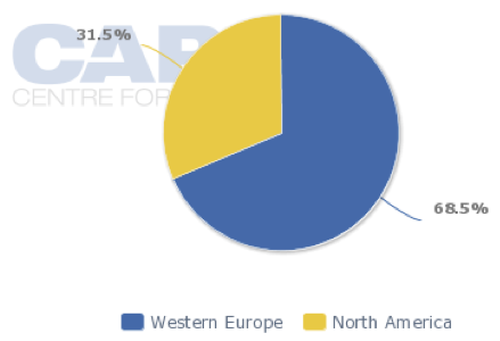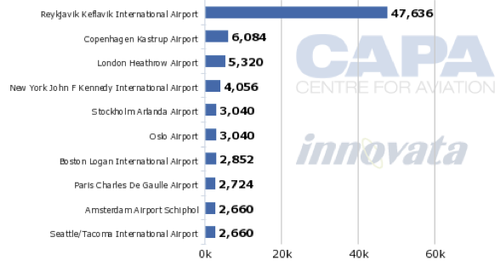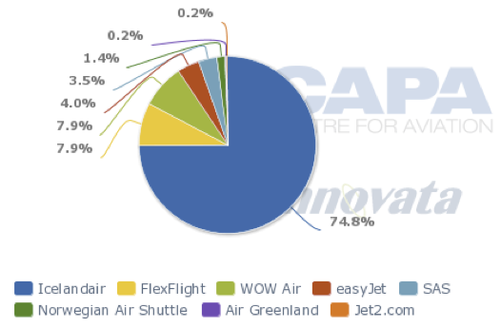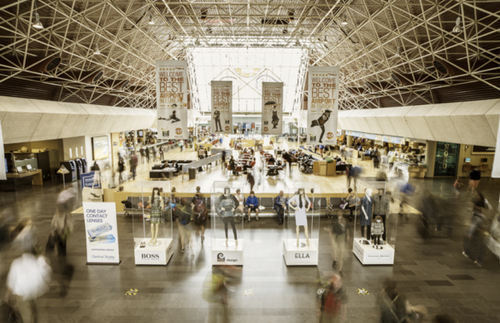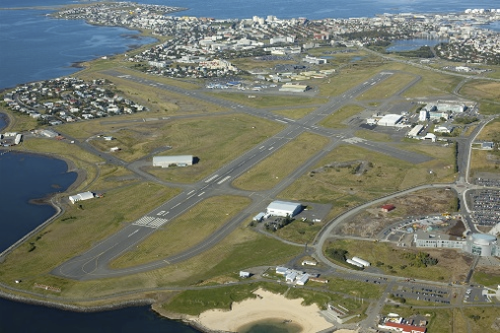Iceland Aviation Inc turns up the heat on its Nordic competitors
The debate continues as to whether or not Scandinavia's airlines would benefit by merging in the current economic climate (meaning SAS Group, Finnair and Norwegian), but across the southern Arctic Ocean to the west there is another airline, together with its home airport and country, that are doing rather well and which, like Copa, Tocumen Airport and Panama City, are gaining regional influence that belies their relative size.
While Iceland/Icelandair/Keflavik Airport may not yet be Singapore/SIA/Changi Airport, or Dubai/Emirates/Dubai Airport in size and scope they are, owing - perversely - partly to a financial crash and an aberrant volcano, a collective force that cannot be ignored. But there is a caveat. Downtown Reykjavik's Lake Tjörnin is a famous magnet for internationally travelling geese and other birds during the summer season. Yet could the influx of airlines that has taken place in Iceland during the year, and which looks likely to gain momentum, kill the goose that laid the golden egg?
- Icelandair has always been a private company, in contrast to SAS and Finnair.
- Icelandair has a long history of pioneering new routes and concepts in the aviation industry.
- The financial crash in 2008 and the volcanic eruption in 2010 were both beneficial to Icelandair and tourism in general.
- Icelandair has successfully expanded its network and now serves 36 cities, including new destinations such as Zurich and St Petersburg.
- Icelandair has outperformed most other European legacy airlines, with increasing revenues and passenger numbers.
- There is a growing interest from other airlines, including low-cost carriers, in flying to Iceland, which may lead to overcapacity in some markets.
Icelandair always a private sector company
Just how different Iceland is from the other countries in and around Scandinavia is brought immediately into sharp focus by a quick overview of the history of Icelandair. It has always been a private company, with no direct involvement by the state, in complete contrast to SAS and Finnair.
Tracing its roots back to the northern city of Akureyri in 1937; the merger of Flugfelag Islands and the independent rival Loftleidir in the 1970s after which a marine company, Eimskip, became the majority shareholder; the divergence into Icelandair Group (flying activities) and FL Group (leasing and investment) in the early 2000s, during which time Icelandair was just one of eleven subsidiaries; the public listing in 2006; the financial crisis; and the subsequent restructuring and its present day ownership by a (reconstituted) bank and a series of pension funds, the airline has always ploughed its own, occasionally slightly eccentric, furrow.
Along the way, and in addition to satisfying the international and domestic travel needs of an island population that was pitched head first into the 20th Century following occupation (by the Allies) in the Second World War, it became known for a series of 'firsts'.
These include being the first transatlantic air ticket discounter, long before better-known names like Laker Airways and People Express, setting up one of the first international 'offshore' base/hubs (at Luxembourg's Findel Airport, operating a fifth freedom Luxembourg-Keflavik-New York service) and pioneering sixth freedom operations at what became a hub at Keflavik Airport, a shared military facility with the US Navy until 2006. Icelandair used the curvature of the earth and the concept of the 'Great Circle Route' to offer shorter elapsed time travel than via most other indirect routes between Europe and North America.
Vertical integration was the key to Icelandair's pre-eminence
Along the way Iceland also pioneered apron transfers at Reykjavik Airport (in the Loftleidir days and often in the freezing middle of the night, though still attractive to students, backpackers and other appreciators of what became known as the 'Hippie Airline').
Latterly, Icelandair established itself as one of the leading exponents of the stopover package on its transatlantic routes, loosely replicating what Singapore Airlines did in the southern hemisphere. It benefited in this respect from a vertical integration with a small number of 3 and 4 star hotels in the capital city, a surface transport provider and tour company, Reykjavik Excursions, and equity holdings in other specialised tourism service providers including a car hire franchise.
To all intent and purpose Icelandair and its associates controlled the market throughout the 1980s and 1990s, to the extent that entry by any other airline apart from global entities such as SAS or Lufthansa was extremely difficult.
One example of an airline that tried, and failed, was Go, the British Airways LCC subsidiary that was eventually sold to easyJet. Go attempted to operate services from London Stansted Airport in the early 2000s solely by selling to the UK visitor market (i.e. ignoring the Icelandic market) and quickly exited. It will be interesting to compare how well easyJet does in 2013 (see later).
The Go analogy is apposite because it hints at how Icelandair has had to change to satisfy the demands of the home population - as well as the visiting and 'passing through' segment - a population which, although still small in number, has now risen to over 320,000 despite net migration in 2009.
Prior to the financial crash in 2008 Iceland had, courtesy of its rich fishing fields and a small but diverse high-tech industrial base (not to mention the false financial services industry strength), one of the highest standards of living in the world, which resulted in a very high propensity to travel amongst the indigenous population - up to six times annually per capita, and for both business and leisure purposes. Thus Icelandair had to juggle the demands of home grown clients with money to spare and expectations of high standards with those of foreign visitors for whom the country was notoriously expensive, and those who were merely seeking the cheapest fare (as Icelandair typically offered) in order to cross the Atlantic, in either direction.
Allied to this conundrum was the one that dictated that most foreign visitor travel to Iceland occurs during a comparatively warm and light 'window' between May and September, while Icelanders themselves, apart from taking regular summer flights to 'sunshine resorts' can take off at any time, to anywhere, in vacation combinations as obscure and esoteric as shopping and soccer or even ballroom dancing.
The complication of how to integrate the year-round demand for cheap transatlantic tickets and of how to satisfy that demand according to the often wildly varying yield in different countries still remains.
Financial crash and ash cloud both an unexpected blessing for Icelandair
Of course these already complex marketing considerations were thrown into even greater confusion by the Apr-2010 volcanic eruption under the Eyjafjallajokull glacier and subsequent ash cloud, which closed down European airspace for the best part of a week, coming on top of the financial crisis. Strangely though, both events turned out to be something of a blessing for Icelandair, which, ironically, suffered less from flight disruption than did many other airlines.
This was partly because of the collapse of the Krona, which devalued by almost 50% against many currencies and which made Iceland 'affordable' to many visitors for the first time; and secondly because of the immense publicity afforded to the country globally through a phalanx of international media on account of the eruption.
There has always been a higher degree of business travel both into and out of Iceland than may first be perceived, driven by the fishing industry, finance (in both good and bad times) and an entrepreneurial spirit throughout a swathe of sectors. But it is from leisure travel that the strongest impetus flows.
Inbound leisure tourism grew steadily from the 1990s onwards, led by Scandinavia (already a mature market), Germany, the US and the UK, and more recently Italy and Spain. Throughout this period Icelandair, which acted as the national Tourist Board in some markets, was almost exclusively responsible for the increase, promoting the country through both long established and new entrant tour operators and in some markets with its own tour products.
Iceland's tourism offering has been broadened and improved
Tourism growth might have been finite, partly because of the seasonal weather factors previously alluded to, and because the country was not a 'repeat destination' for many visitors. Most of the major and best-known physical tourism attractions of the country, which essentially involve the contrast between ice (glaciers/waterfalls) and fire (volcanic activity) can be visited on a single day's excursion from Reykjavik and travel around the country beyond can be arduous outside of high season, and only for the committed hiker, mountaineer or nature lover.
Activities such as whale watching, viewing the Northern Lights (Aurora Borealis) and swimming in the 'Blue Lagoon' geothermal spa close to Keflavik Airport were available but underdeveloped.
But the aforementioned influence of the currency devaluation and the 2010 volcanic eruption conspired with the addition of new attractions, some of them indoor ones to avoid weather and light-related issues, to create new markets.
Many of these attractions were introduced during the economic boom period in the first half of the 2000s and have persevered where some of the banks and financiers of the same era have not. What was already a well established restaurant/bar/cultural/music scene has been further enhanced to the point where Iceland can genuinely refer to itself as a European gastronomic centre.
Literary and music scene attracts global interest
Meanwhile, the country's tradition of finding contemporary and globally acclaimed writers like Hallgrimur Helgason and international rock music stars from a small population (The Sugarcubes and Bjork, Gus Gus, Sigur Ros etc) continues today with a new wave, led by Of Monsters and Men, which has endeared Iceland to successive generations of popular music followers worldwide, creating considerable international goodwill and interest in the country.
There is a clear comparison to be made here with Korea and how it attracts youthful visitors in droves from countries such as Japan and China in a similar fashion (and long before the advent of Psy and Gangnam Style). The futuristic Harpa (named after the first summer month of the old Icelandic calendar), a new music and convention hall, was opened in 2011, actively promoting its mid-Atlantic location, and is a key component of Iceland Airwaves, a week-long rock festival held each November (well outside the traditional tourist season) and sponsored by Icelandair, as is the Food&Fun Festival in February.
While Iceland was never short on tourism infrastructure, almost all hotel accommodation fell into the 3-4 star category but the portfolio has been broadened out to include a much wider range of establishments, together with a panoply of short-term apartment lets.
In support of commercial/business tourism Harpa also provided a dedicated convention facility, something the country was long criticised for not having; and its opening gave a further boost to the existing hotel-based convention business as typically happens wherever a designated conference centre is constructed.
The advantage that Iceland has is decades of experience of handling corporate incentive itineraries and product launches (especially motor vehicles) ensured that, together with Harpa, the country was able to pitch globally for new business across the range of the MICE (Meetings, Incentives, Conferences, Exhibitions) tourism business segment and to compete on at least equal terms with its Nordic neighbours.
Iceland being promoted as a year-round destination as tourism numbers grow by almost 40% in 1Q2013
The result of this activity is that Icelandair now feels sufficiently confident to promote Iceland as a year-round tourism destination, though the need to continue to iron out seasonal fluctuations is acknowledged.
The visitor figures are impressive. The Iceland Tourism board statistics for 1Q2013 (Jan-Mar) show that the number of visitors grew by 39.3% over 2012,and the 2012 figures were themselves much higher than the 2011 figures. This compares with a 6.5% increase in Denmark (in Jan & Feb-2013 only) and 6% in Norway (hotels/camping visitors only). Figures in Sweden, while not made available, are believed to be of a similar order.
And Icelandair expands while others around it shrink
Icelandair has continuously taken the lead in driving tourism growth and in doing so has extended its network to the point that the airline now serves 36 cities (11 of them in North America compared to just four for SAS), including New York Newark (doubling up in the metropolitan area with the existing JFK service) and Anchorage; also Zurich and St Petersburg, all new for 2013. The 2013 timetable is the largest in Icelandair's 76 year history and is 15% bigger than last year. The introduction of St Petersburg is intriguing because Icelandair has never promoted itself as an eastward looking carrier (as Finnair has).
The service will inevitably attract incoming Russian visitors but a more tantalising prospect is if the eastward trend were to be continued, to, say, Moscow, thus permitting Iceland to add another northern air bridge to its portfolio to challenge Finnair and SAS directly (e.g. Washington-Moscow).
Those with long memories will recall that the Reagan-Gorbachev meeting that was the beginning of the end of the Cold War took place in Iceland in 1986, a helpful halfway house.
Icelandair Network Summary (at 28-Apr-2013)
|
Total non-stop passenger destinations |
23 |
|---|---|
|
Domestic |
1 |
|
0 |
|
|
0 |
|
|
Schengen Europe |
11 |
|
Other Europe |
4 |
|
0 |
|
|
0 |
|
|
7 |
|
|
Total non-stop freight destinations |
4 |
|
Domestic |
1 |
|
0 |
|
|
0 |
|
|
2 |
|
|
0 |
|
|
0 |
|
|
1 |
Icelandair international capacity, seats by region, period 22 to 28-Apr-2013
Icelandair top 10 hubs/bases/stationsby seats, period 22 to 28-Apr-2013
Icelandair has selectively engaged in code-sharing agreements in the Americas. An early one, in the 1990s, was with Southwest Airlines (which had a major hub at Baltimore - Washington Airport [BWI]; an Icelandair gateway for several years, subsequently removed then replaced with Dulles Airport). It was perhaps a uniquely experimental relationship for the Dallas Love Field based carrier.
Latterly there was an agreement with Alaska Airlines at Seattle, a more recent Icelandair gateway, but that will end in Jun-2013. Presumably, the fact that Icelandair will itself start to fly to Anchorage in 2013 weighed on that decision. The Alaska Airlines agreement is replaced by one with Canada's WestJet, which can offer interlining at both Toronto Pearson and Halifax airports, and which itself benefits from feed into Icelandair's 20 European cities without having to commence services of its own (as Air Canada expands its new LCC 'Rouge' into fresh European gateways).
Icelandair outperforms most other European legacy airlines
Icelandair momentarily, at least, goes from strength to strength, outperforming virtually all other European legacy airlines. The carrier announced a firm order for 16 B737 MAX aircraft in Feb-2013, worth over USD1.6 billion at list prices, to complement its existing B757 -200 and -300 operations (it is one of the biggest operators of this now largely ignored variant, which suits it network arrangement perfectly) and to permit continuing route expansion.
Additionally, it purchased two more B757-200 aircraft in January 2013, paid with its own funds, and which will join its existing fleet of 16 aircraft in summer 2013, all of them capable of ETOPs operations.
Icelandair Group had a total fleet of 39 aircraft as at 31-Dec-2012 including 24 owned and 15 leased aircraft. Icelandair operated 17; Icelandair Cargo operated four, Loftleidir operated nine (mainly as ACMI), and Air Iceland operated eight. The Group also has one additional aircraft not allocated to any of the carriers.
One small problem Icelandair Group has for the moment is that the fleet, once touted as the youngest in Europe, is now ageing and now shows an average age of 17.8 years. The average is dragged up by some elderly freighters and by Air Iceland's Fokker 50s, but even its international passenger fleet is around the mid-teens.
Icelandair Fleet Summary: as at 24-Apr-2013
|
Aircraft |
In Service |
In Storage |
On Order |
|---|---|---|---|
In the 12 months ended 31-Dec- 2012, Icelandair revenues increased to USD899 million (+13.7%), operating profit to USD50.8 million (+31.5%) and net profit to USD44.3 million (+21.9%). International passenger numbers grew by 16% and load factor to 80.6%. The 2013 forecast is for EBITDA of USD115 million to USD120 million as the flight schedule grows. Of the other Nordic region airlines only Norwegian Air Shuttle can point to positive financials that bear any comparison.
Air Iceland exists as a semi-autonomous wholly-owned entity of Icelandair with its own CEO, based at Reykjavik's downtown airport and at Akureyri Airport in the north. The fleet comprises two Bombardier Dash 8-202s and six Fokker F50s. Most of its routes are domestic though it does also fly internationally, to four cities in Greenland and to the Faroe Islands.
LCCs queuing up to fly into Iceland
During the last few years, as the market has grown, there has been a slow and steady interest shown by other airlines in flying to Iceland, specifically the country's chief gateway, Keflavik Airport, which is situated some 50 km (30 miles) southwest of Reykjavik on the volcanic Reykjanes Peninsula.
In the last few years foreign airline interest stopped being steady and accelerated. Some of the airlines were/are indigenous, such as Iceland Express and its successor, WOW, while others include LCCs such as easyJet, Norwegian, Vueling and Germanwings, together with alternative long haul carriers such as Delta.
Although lower in the shoulder period, for the summer 2013 season there will be 17 passenger airlines operating at Keflavik (mainly, still, in the summer, dropping down to five in the winter) including Icelandair and WOW.
This is a considerable increase in capacity and comes at a time when Icelandair would expect to make most of its profit for the year. The prevalence of LCCs must be of some concern to Icelandair. At the last count they numbered seven, including the home-grown WOW, which commenced operations on 01-Jun-2012 and which has rapidly built up a network of cities in Denmark, France, Germany, Poland, Spain, Switzerland, Italy, Austria, Lithuania and the United Kingdom with four A320 aircraft.
Along the way WOW acquired Iceland Express, also an LCC, but which over-extended itself with fanciful long haul services, including one to Winnipeg, Canada, which seemed to be based solely on the opening of a new museum there and the location of a small Icelandic community in a town (Gimli) to the north of the city.
Reykjavik Keflavik International Airport capacity, seats per week, all carriers, period 22 to 28-Apr-2013
Reykjavik Keflavik International Airport Network Summary (at 22-Apr-2013)
|
9 |
|
|---|---|
|
Domestic only |
0 |
|
International |
9 |
|
Total non-stop passenger destinations |
28 |
|
Domestic |
0 |
|
0 |
|
|
0 |
|
|
Schengen Europe |
13 |
|
Other Europe |
8 |
|
0 |
|
|
0 |
|
|
7 |
|
|
Total non-stop freight destinations |
4 |
|
Domestic |
0 |
|
0 |
|
|
0 |
|
|
3 |
|
|
0 |
|
|
0 |
|
|
1 |
Overcapacity in the UK market?
Perhaps the best example of what may become an overcapacity scenario is the UK market in winter where, collectively, Icelandair, easyJet and WOW offered 26 flights a week just to London in Feb-2013, compared to 19 in 2012; and the total will go up to 37 in 2014. (Source: turisti.is)
In addition there are new flights from Manchester and Edinburgh by easyJet this year. Of even more concern might be the fact that Jet2.com is testing the water with what it calls 'discovery destination' flights in 2013 (effectively charter test flights to gauge demand) from Leeds-Bradford, Newcastle and (again) Edinburgh Airport. The threat from Jet2.com arises from its ability to market all-in package holidays to city-break destinations across Europe on its scheduled services. Reykjavik may well be next.
In the event, trade with the UK is booming. According to American Express the Icelandic Krona is the third fastest growing foreign currency transaction in the UK in 1Q2013 after the Thai Baht and the Egyptian Pound and has moved into 18th position in the sales league table.
It was a matter of only a little over 10 years or so ago that the only scheduled services between the UK and Iceland were from London Heathrow and Glasgow airports (the latter very popular with Iceland residents for shopping trips) and they amounted to just nine a week.
One of the attractions to passengers of using Icelandair services historically has been the ease of transit through the Leifur Eriksson terminal building at Keflavik Airport, even though that facility has no direct connection with the airline.
The aesthetically pleasing terminal opened in1987 and was later extended with the opening of the South Building in 2001 (not a separate terminal, it remains a single terminal facility, one of its main attractions) to comply with the requirements of the Schengen Agreement. The existing North Building was later enlarged. There are plans either to enlarge it further or to build a completely new terminal building in 2015 or 2016.
Keflavik International Airport
Keflavik Airport shows no sign of preparation for airport privatisation
Keflavik Airport is operated by ISAVIA Ltd., a private limited company with 100% government ownership, a variety of corporatisation. Intriguingly, as far as it is known, outright privatisation has never seriously been discussed, despite the fact that the 'national flag carrier' has never had any public sector interest.
But then again, why would it? There is no competition to the airport and it can keep its charges reasonably high (there is no prospect of seeing Ryanair there any time soon). Several years ago the opportunity of building a new airport in the Reykjavik suburbs close to the existing downtown Reykjavik Airport was mooted.
Reykjavik Airport serves mainly domestic services though it also handles some Greenland and Faroe Islands traffic and takes diversions from Keflavik when necessary. Its operating license is governed by the city's urban plan, which expires in 2016, hence the proposal for a new airport. But that is an unreasonable prospect; for one thing the costs would be influenced by the need to hack a runway(s) and supporting infrastructure out of solid volcanic rock, just as the two existing airports were (in wartime, when cost wasn't an issue).
As it happens, the Ministry of the Interior and the Reykjavík Mayors Office signed an agreement late in Apr-2013 to develop a new terminal building for Reykjavík Airport. Construction of the 2500sqm facility is due to commence during the northern winter, and is scheduled to be completed in 2015. Investment required for the facility is estimated at ISK750 million to ISK1 billion (EUR4.9-6.6 million). The new terminal building will be double the size of the existing facility and will allow all carriers to operate from a single terminal.
Reykjavik's downtown airport
Keflavik Airport's passenger profile for 2012 revealed that 36% of passengers were of Icelandic origin. Of the other countries, the US and the UK led the field with 9% each, followed by Germany with 6%. The other Nordic countries collectively had 14% between them despite their relatively thin populations, emphasising the fact that even though these markets are now very mature they remain highly important. Russia registered 0%. That is likely to change soon.
The highest ranking category of passengers (25%) was in the age range 26-34. 86% of passengers were travelling for leisure purposes and 14% on business. 68% were point-to-point and an impressive 32% were connecting via the airport (with or without stopover). Average aircraft load factor ranged between 69% (January) and 81% (July and August).
In totalKeflavik Airport counted 2,380,000 passengers (+12.68%) in 2012, the highest figure ever recorded. (The previous highest was in 2007; in 2009 it collapsed to 1,658,000). Average passenger growth in the first quarter of 2013 broadly mirrors the Tourist Board figures mentioned previously - 21.6% in Jan; 23.6% in Feb; and 30.1% in Mar - or 25.1% overall.
While 'peakiness' remains in choice of month of travel (e.g. 102,400 in Jan-2012 versus 363,000 in Jul-2012) there was notably less peakiness in selection of day of week to travel, varying between a minimum of 294,000 on Wednesdays and a maximum of 383,000 on Sundays. This indicates that Iceland is losing its 'weekend tourism' tag, both out and inbound.
Despite the large and growing number of low cost airlines there are no known plans for any sort of airport facility dedicated to them, unlike, for example, the low cost terminal at Copenhagen Airport.
Re-election of political parties that plunged Iceland into economic disaster should not impact on travel and tourism
As this report is published it appears that the two centre-right parties (Independence and Progressive) which were, in the main, blamed for Iceland's economic meltdown, have been elected back into power for the first time since 2007. Like many other governments elected to 'clean up a mess' the coalition between the Social Democratic Alliance and Left-Green movement became unpopular.
It is perhaps too early for analysts even to speculate on what the implications might be for tourism and for the various airlines and airports mentioned here but the agencies concerned in Iceland will surely be doing that.
One thing is certain. The Progressive Party in particular is anti-EU (i.e. against joining the EU as a full member). That is perhaps not significant where tourism and air travel are concerned. Iceland is already a member of the wider European Economic Area and benefits from many of the EU's economic policies such as Open Skies while avoiding the degree of legislative control Brussels exhibits over its member countries and which might well adversely affect prospects in the Icelandic fishing industries. It seems clear that the majority of the population wants things to stay that way and the citizens of many other countries might well sympathise with them.
The Progressive Party was also the one most fiercely opposed to Iceland repaying the UK and the Netherlands for the failure of the Icesave online bank (Landsbanki), after those governments covered the losses of their citizens, which collectively amounted to around EUR4 billion.
Presumably it will take a similar stance again. That might lead to tensions with those countries. But again, this is unlikely to influence tourism negatively. If the figure was EUR40 billion perhaps, but for most potential visitors to Iceland and passengers on Icelandair, unless there is a serious change of philosophy in the government that is deemed unacceptable internationally, politics will remain well down the list of the dynamics influencing foreign consumer decisions, and well behind the existing 'pull factors' of unique visitor attractions, value for money, and, in the air on the North Atlantic routes, convenient and relatively inexpensive travel.
In conclusion:
- Icelandair largely takes the credit for building traffic numbers out of, into and through Iceland, over many decades and to the present day;
- It did this partly through a sophisticated vertical integration policy;
- The financial crash in 2008 and 2010 volcanic eruption were both, perversely, beneficial to Icelandair and to tourism in general;
- The tourism product has been revamped and extended, opening new opportunities;
- Visitor numbers are increasing rapidly, including during the winter season;
- Icelandair is outperforming almost all its European legacy airline rivals;
- New airlines are being attracted every year. There is the danger of overcapacity in some markets.
